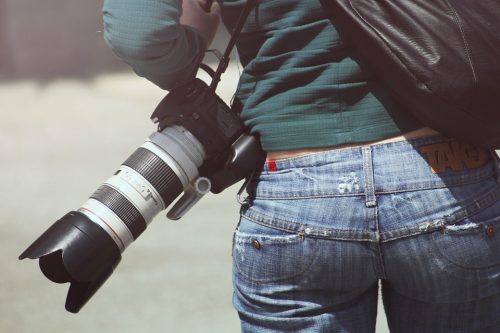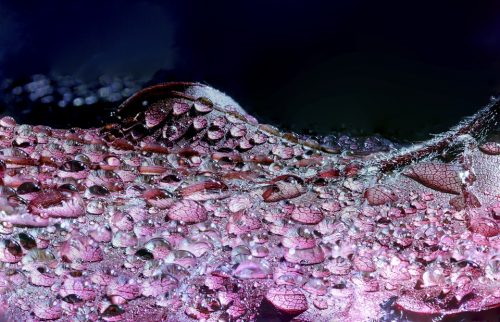 Standard and Kit lenses
When you purchased your DSLR camera, it may have come with a “kit” or starter lens. Kit lenses vary according to camera and manufacturer but they are referred to as “kit” because they are sold together as part of a package with the camera body and accessories you need to get started. These are usually zoom lenses that fall within the standard focal range of 35-70mm. This range is closest to the perspective of the human eye. A 50mm lens is generally considered the closest to human sight. Understanding this, will make it easier to understand the other types of lenses, which allow you to capture a wider area of a scene than the regular eye would, or to magnify far away objects so that you can see them closer and more clearly than you’d be able to with an unaided eye.
Prime vs. Zoom Lenses
There are two types of lenses, prime and zoom. Prime lenses have one fixed focal length while zoom lenses have variable focal lengths, meaning that you can adjust them to zoom in and out on your subject, changing your focal length and angle of view. Prime lenses usually have larger maximum apertures, which can be helpful in low light situations. Popular prime lenses are 35mm, 50mm, and 85mm. Zoom lenses can fall within one focal length category or span multiple focal length categories. For example, an 18-35mm zoom lens would be strictly in the wide range, while a 24-70mm zoom would fall within both the wide and standard rages. Some zoom lenses can even fall within three ranges, such as the 24-105mm lens, which covers wide, standard, and short telephoto. If you opt for the 24-105mm, you would use the shorter 24mm option for landscapes and the longer 70-105mm range for taking photographs of your family.
Fish Eye Lens – 18mm or Less
A fisheye lens, also known as an "ultra wide" or "super wide" lens, produces highly distorted images that have a dynamic, abstract feel. This type of lens is popular for photographing extremely wide panoramas of landscapes and the sky, and for shooting close-up subjects such as crowds, interiors, and architecture. They are also commonly used to photograph action sports such as skateboarding, snowboarding, and surfing. Many photographers also use them to take intriguing and distorted photographs of all types of subjects, from still life to portraits.
Standard and Kit lenses
When you purchased your DSLR camera, it may have come with a “kit” or starter lens. Kit lenses vary according to camera and manufacturer but they are referred to as “kit” because they are sold together as part of a package with the camera body and accessories you need to get started. These are usually zoom lenses that fall within the standard focal range of 35-70mm. This range is closest to the perspective of the human eye. A 50mm lens is generally considered the closest to human sight. Understanding this, will make it easier to understand the other types of lenses, which allow you to capture a wider area of a scene than the regular eye would, or to magnify far away objects so that you can see them closer and more clearly than you’d be able to with an unaided eye.
Prime vs. Zoom Lenses
There are two types of lenses, prime and zoom. Prime lenses have one fixed focal length while zoom lenses have variable focal lengths, meaning that you can adjust them to zoom in and out on your subject, changing your focal length and angle of view. Prime lenses usually have larger maximum apertures, which can be helpful in low light situations. Popular prime lenses are 35mm, 50mm, and 85mm. Zoom lenses can fall within one focal length category or span multiple focal length categories. For example, an 18-35mm zoom lens would be strictly in the wide range, while a 24-70mm zoom would fall within both the wide and standard rages. Some zoom lenses can even fall within three ranges, such as the 24-105mm lens, which covers wide, standard, and short telephoto. If you opt for the 24-105mm, you would use the shorter 24mm option for landscapes and the longer 70-105mm range for taking photographs of your family.
Fish Eye Lens – 18mm or Less
A fisheye lens, also known as an "ultra wide" or "super wide" lens, produces highly distorted images that have a dynamic, abstract feel. This type of lens is popular for photographing extremely wide panoramas of landscapes and the sky, and for shooting close-up subjects such as crowds, interiors, and architecture. They are also commonly used to photograph action sports such as skateboarding, snowboarding, and surfing. Many photographers also use them to take intriguing and distorted photographs of all types of subjects, from still life to portraits.
 Wide Angle Lens – 20-35mm
This lens has a short focal length that captures a wider view. It is useful for landscapes, for architecture, or for situations where you may want an area to look larger or more spacious, like interiors. Many people only reach for this lens when trying to get the whole subject in the frame, whether that's a building, a large group of people or a landscape. However, while those are perfectly good uses, they can also be used for interesting portraits where you want to place a subject in the middle of a situation. Just be careful not to distort faces by shooting too close.
Telephoto Lens – 70mm and Above
These lenses like the Canon EF 70-200mm from Beachcamera.com have long focal lengths that result in magnification of the subject and are useful for photographing sports and wildlife that you can’t or don’t want to get close to.
Wide Angle Lens – 20-35mm
This lens has a short focal length that captures a wider view. It is useful for landscapes, for architecture, or for situations where you may want an area to look larger or more spacious, like interiors. Many people only reach for this lens when trying to get the whole subject in the frame, whether that's a building, a large group of people or a landscape. However, while those are perfectly good uses, they can also be used for interesting portraits where you want to place a subject in the middle of a situation. Just be careful not to distort faces by shooting too close.
Telephoto Lens – 70mm and Above
These lenses like the Canon EF 70-200mm from Beachcamera.com have long focal lengths that result in magnification of the subject and are useful for photographing sports and wildlife that you can’t or don’t want to get close to.
 Macro Lens
Macro lenses magnify your subject and allow for focusing at closer distances. With a macro lens from Beachcamera.com you can focus on your subject while only a few inches away. Macro lenses are useful for shooting extreme close ups of small objects like insects or for capturing small details of a larger subject like flowers.
Macro Lens
Macro lenses magnify your subject and allow for focusing at closer distances. With a macro lens from Beachcamera.com you can focus on your subject while only a few inches away. Macro lenses are useful for shooting extreme close ups of small objects like insects or for capturing small details of a larger subject like flowers.
 Now that you’ve seen how different lenses can give you the creative freedom to take a variety of images, we hope this has helped you understand what to look for when you feel it is time to look for a new lens at Beachcamera.com so you can expand your photography horizons.
Now that you’ve seen how different lenses can give you the creative freedom to take a variety of images, we hope this has helped you understand what to look for when you feel it is time to look for a new lens at Beachcamera.com so you can expand your photography horizons.








































